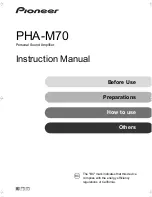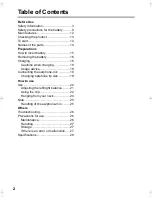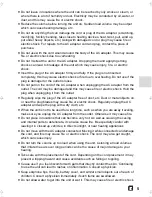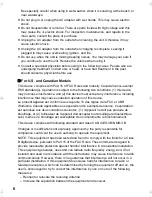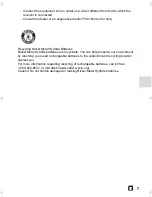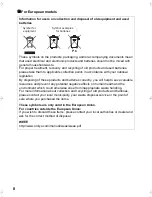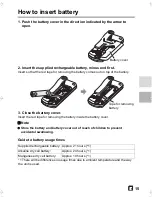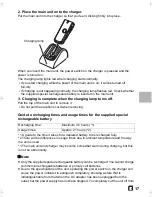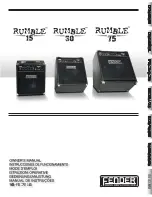
6
Be especially careful when using in wet weather, when it is snowing, at the beach, or
near waterways.
≥
Do not plug in or unplug the AC adapter with wet hands. This may cause electric
shock.
≥
Do not disassemble or remodel. There are parts inside with high voltage and this
may cause fire or electric shock. For inspection, maintenance, and repairs to the
inner parts, consult the place of purchase.
≥
Unplug the AC adapter from the outlet when cleaning the unit. Otherwise it may
cause electric shock.
≥
Unplug the AC adapter from the outlet when charging is complete. Leaving it
plugged in may cause overheating, ignition, and fire.
≥
Do not use when the unit is making beeping noises. You may damage your ears if
you continue to use the unit. Reduce the volume when using it.
≥
Consult a specialist physician before using in the following cases. People who are
undergoing treatment on their ears or head, or have had treatment in the past,
should consult a physician before use.
∫
For U.S. and Canadian Models
This device complies with Part 15 of FCC Rules and Industry Canada licence-exempt
RSS standard(s). Operation is subject to the following two conditions: (1) this device
may not cause interference, and (2) this device must accept any interference, including
interference that may cause undesired operation of this device.
Le present appareil est conforme aux la partie 15 des regles de la FCC et CNR
d'Industrie Canada applicables aux appareils radio exempts de licence. L'exploitation
est autorisee aux deux conditions suivantes : (1) l'appareil ne doit pas produire de
brouillage, et (2) l'utilisateur de l'appareil doit accepter tout brouillage radioelectrique
subi, meme si le brouillage est susceptible d'en compromettre le fonctionnement.
This device complies with following standard and class CAN ICES-3 B/NMB-3 B
Changes or modifications not expressly approved by the party responsible for
compliance could void the user’s authority to operate the equipment.
NOTE: This equipment has been tested and found to comply with the limits for a Class
B digital device, pursuant to Part 15 of the FCC Rules. These limits are designed to
provide reasonable protection against harmful interference in a residential installation.
This equipment generates, uses and can radiate radio frequency energy and, if not
installed and used in accordance with the instructions, may cause interference to radio
communications. However, there is no guarantee that interference will not occur in a
particular installation. If this equipment does cause harmful interference to radio or
television reception, which can be determined by turning the equipment off and on, the
user is encouraged to try to correct the interference by one or more of the following
measures:
– Reorient or relocate the receiving antenna.
– Increase the separation between the equipment and receiver.
SN29403330_PHA-M70_EnFrEs.book 6 ページ 2017年12月7日 木曜日 午前11時28分

